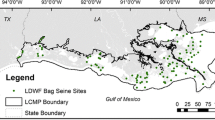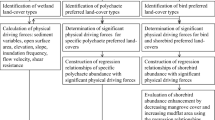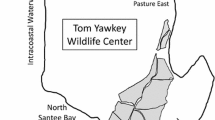Abstract
A habitat-based framework is a practical method for developing models (or, ecological production functions, EPFs) to describe the spatial distribution of ecosystem services. To generate EPFs for Yaquina estuary, Oregon, USA, we compared bird use patterns among intertidal habitats. Visual censuses were used to quantify abundance of bird groups and general species richness in: Zostera marina (eelgrass), Upogebia (mud shrimp)/mudflat, Neotrypaea (ghost shrimp)/sandflat, Zostera japonica (Japanese eelgrass), and low marsh estuarine habitats. Also assessed were (1) spatial variation within a habitat along the estuary gradient and, (2) temporal variation based on bi-monthly samples over a year at five tidal ranges. Z. marina was an important estuarine habitat based on nearly all metrics of bird use, except for shorebird densities. This suggests that reductions in native eelgrass habitat may reduce the abundance and diversity of birds in Yaquina estuary. Our results suggest that a habitat based assessment approach is generally feasible for developing relative EPFs related to the presence of birds within estuarine systems.







Similar content being viewed by others
References
Baldwin J, Lovvorn J (1994a) Habitats and tidal accessibility of the marine foods of dabbling ducks and brant in Boundary Bay, British-Columbia. Mar Biol 120:627–638. doi:10.1007/BF00350084
Baldwin JR, Lovvorn JR (1994b) Expansion of seagrass habitat by the exotic Zostera japonica, and its use by dabbling ducks and brant in Boundary Bay, British Columbia. Mar Ecol Prog Ser 103:119–127
Batker D, Swedeen P, Costanza R et al (2008) A new view of the Puget Sound economy: the economic value of nature’s services in the Puget Sound basin. Earth Economics, Seattle
Benoit LK, Askins RA (2002) Relationship between habitat area and the distribution of tidal marsh birds. Wilson Bull 114:314–323
Buchanan JB (1988) The abundance and migration of shorebirds at two Puget Sound estuaries. West Birds 19:69–78
Buchanan JB, Evenson JR (1997) Abundance of shorebirds at Willapa Bay, Washington. West Birds 28:158–168
Clarke K, Green R (1988) Statistical design and analysis for a biological effects study. Mar Ecol Prog Ser 46:213–226. doi:10.3354/meps046213
Clinton PJ, Young, Specht DT, Lee H (2007) A guide to mapping intertidal eelgrass and nonvegetated habitats in estuaries of the Pacific Northwest USA. U.S. Environmental Protection Agency, Washington, DC EPA/600/R-07/062
Colwell M (1993) Shorebird community patterns in a seasonally dynamic estuary. Condor 95:104–114. doi:10.2307/1369391
Colwell MA (1994) Shorebirds of Humboldt Bay, California: abundance estimates and conservation implications. West Birds 25:137–145
Connors S (2008) Shorebird use of muted tidal wetlands in a California estuary. West Birds 39:153–165
Connors P, Myers J, Connors C, Pitelka F (1981) Interhabitat movements by sanderlings in relation to foraging profitability and the tidal cycle. Auk 98:49–64
Cork SJ, Proctor W, Shelton D et al (2002) The ecosystem services project: exploring the importance of ecosystems to people. Ecol Manag Restor 3:143–146
Costanza R, dArge R, deGroot R et al (1997) The value of the world’s ecosystem services and natural capital. Nature 387:253–260. doi:10.1038/387253a0
Daily G (1997) Nature’s services: societal dependence on natural ecosystems, 1st edn. Island Press, Washington, DC
Daily GC, Alexander S, Ehrlich PR et al (1997) Ecosystem services: benefits supplied to human societies by natural ecosystems. Ecological Society of America, Washington, DC
Dean Runyon Associates (2009) Fishing, hunting, wildlife viewing, and shellfishing in Oregon 2008 state and county expenditure estimates. Prepared for the Oregon Department of Fish and Wildlife Travel Oregon, Portland, OR, USA
DeWitt TH, D’Andrea AF, Brown CA, Griffen BD, Eldridge PM (2004) Impact of burrowing shrimp populations on nitrogen cycling and water quality in western North American temperate estuaries. In: Tamaki A (ed) Proceedings of the symposium on ecology of large bioturbators in tidal flats and shallow sublittoral sediments—from individual behavior to their role as ecosystem engineers. University of Nagasaki, Japan, pp 107–118
Ferraro SP, Cole FA (2007) Benthic macrofauna–habitat associations in Willapa Bay, Washington, USA. Estuar Coast Shelf Sci 71:491–507. doi:10.1016/j.ecss.2006.09.002
Ferraro SP, Cole FA (2010) Ecological periodic tables for nekton usage of four US Pacific Northwest estuarine habitats. Can J Fish Aquat Sci 67:1957–1967. doi:10.1139/F10-114
Ferraro SP, Cole FA (2011) Ecological periodic tables for benthic macrofaunal usage of estuarine habitats in the US Pacific Northwest. Estuar Coast Shelf Sci 94:36–47. doi:10.1016/j.ecss.2011.05.011
Glass GV, Peckham PD, Sanders JR (1972) Consequences of failure to meet assumptions underlying fixed effects analyses of variance and covariance. Rev Educ Res 42:237–288
Harwell MR, Rubinstein EN, Hayes WS, Olds CC (1992) Summarizing Monte Carlo results in methodological research: the one- and two-factor fixed effects ANOVA cases. J Educ Stat 17:315–339
Hothorn T, Bretz F, Westfall P (2008) Simultaneous inference in general parametric models. Biom J 50:346–363
Hurlbert S (1971) Nonconcept of species diversity—critique and alternative parameters. Ecology 52:577–586. doi:10.2307/1934145
Janousek C, Folger C (2013) Variation in tidal wetland plant diversity and composition within and among coastal estuaries: assessing the relative importance of environmental gradients. J Veg Sci. doi:10.1111/jvs.12107
Kaldy JE (2006) Production ecology of the non-indigenous seagrass, dwarf eelgrass (Zostera japonica Ascher. & Graeb.), in a Pacific Northwest estuary, USA. Hydrobiologia 560:433. doi:10.1007/s10750-006-9001-1
Lamberson JO, Frazier MR, Nelson WG, Clinton PJ (2011) Utilization patterns of intertidal habitats by birds in Yaquina estuary, Oregon. U.S. EPA, Office of Research and Development, National Health and Environmental Effects Research Laboratory, Western Ecology Division
Lee II H, Brown C (2009) Classification of regional patterns of environmental drivers and benthic habitats in Pacific Northwest estuaries. U.S. EPA, Office of Research and Development, National Health and Environmental Effects Research Laboratory, Western Ecology Division
McKinney RA, McWilliams SR, Charpentier MA (2006) Waterfowl-habitat associations during winter in an urban North Atlantic estuary. Biol Conserv 132:239–249. doi:10.1016/j.biocon.2006.04.002
Merrifield K (1998) Waterbird censuses of Yaquina Bay, Oregon, March 1993–February 1994. Wildlife Diversity Program, Oregon Dept. of Fish and Wildlife, Corvallis, OR
Merrifield K (2001) Larid, alcid, and crow censuses of Yaquina Bay, Oregon, June 1997–June 1999. Oregon Department of Fish and Wildlife, Wildlife Diversity Program, Portland, OR
Millennium Ecosystem Assessment (2005a) Ecosystems and human well-being: wetlands and water synthesis. World Resources Institute, Washington, DC
Millennium Ecosystem Assessment (2005b) Ecosystems and human well-being: synthesis. Island Press, Washington, DC
Moore JE, Black JM (2006) Slave to the tides: spatiotemporal foraging dynamics of spring staging Black Brant. Condor 108:661–677
National Research Council (2004) Valuing ecosystem services: toward better environmental decision-making. The National Academies Press, Washington, DC
Nelson E, Mendoza G, Regetz J et al (2009) Modeling multiple ecosystem services, biodiversity conservation, commodity production, and tradeoffs at landscape scales. Front Ecol Environ 7:4–11. doi:10.1890/080023
O’Higgins TG, Ferraro SP, Dantin DD et al (2010) Habitat scale mapping of fisheries ecosystem service values in estuaries. Ecol Soc 15:7
Oksanen J, Kindt R, Legendre P et al (2009) Vegan: community ecology package. R package version 1.13–1
Page GW, Stenzel LE, Kjelmyr JE (1999) Overview of shorebird abundance and distribution in wetlands of the Pacific Coast of the contiguous United States. Condor 101:461–471. doi:10.2307/1370176
Pendleton LH (ed) (2009) The economic and market value of America’s coasts and estuaries: What’s at stake. Coastal Ocean Values Press, Washington, DC
Pielou EC (1969) An introduction to mathematical ecology. Wiley-Interscience, NY
Pinheiro J, Bates D, DebRoy S et al (2009) nlme: linear and nonlinear mixed effects models. R package version 3.1–92
Polasky S (2008) What’s nature done for you lately: measuring the value of ecosystem services. Choices 23:42–46
R Development Core Team (2008) R: a language and environment for statistical computing. R Foundation for Statistical Computing, Vienna, Austria
Scranton RW (2004) The application of Geographic Information Systems for delineation and classification of tidal wetlands for resource management of Oregon’s coastal watersheds. Thesis, Marine Resources Management Program, Oregon State University, Corvallis
Shuford WD, Page GW, Evans JG, Stenzel LE (1989) Seasonal abundance of waterbirds at Point Reyes: a coastal California perspective. West Birds 20:137–265
Southwick Associates, Inc. (2008) The 2006 economic benefits of wildlife-viewing recreation in Florida. 32
U.S. Department of the Interior, Fish and Wildlife Service (2009) Birding in the United States: a demographic and economic analysis: addendum to the 2006 national survey of fishing, hunting, and wildlife-associated recreation. 16
U.S. Department of the Interior, Fish and Wildlife Service, U.S. Department of Commerce, U.S. Census Bureau (2007) 2006 National survey of fishing, hunting, and wildlife-associated recreation. 164
Warnock SE, Takekawa JY (1995) Habitat preferences of wintering shorebirds in a temporally changing environment: western Sandpipers in the San Francisco Bay estuary. Auk 112:920–930
Warnock N, Page GW, Ruhlen TD et al (2002) Management and conservation of San Francisco Bay salt ponds: effects of pond salinity, area, tide, and season on Pacific flyway waterbirds. Waterbirds 25:79–92
Wenny DG, DeVault TL, Johnson MD et al (2011) The need to quantify ecosystem services provided by birds. Auk 128:1–14. doi:10.1525/auk.2011.10248
Wetzel DJ (1996) Brant use of Yaquina estuary, Lincoln County, Oregon in the spring of 1976. J Or Ornithol 6:715–722
Wilson UW, Atkinson JB (1995) Black brant winter and spring-staging use at two Washington coastal areas in relation to eelgrass abundance. Condor 97:91–98. doi:10.2307/1368986
Woodward RT, Wui YS (2001) The economic value of wetland services: a meta-analysis. Ecol Econ 37:257–270. doi:10.1016/S0921-8009(00)00276-7
Young DR, Clinton PJ, Specht DT et al (2008) Monitoring the expanding distribution of nonindigenous dwarf eelgrass Zostera japonica in a Pacific Northwest USA estuary using high resolution digital aerial orthophotography. J Spat Sci 53:87–97. doi:10.1080/14498596.2008.9635138
Acknowledgments
The authors thank Drs. Rick McKinney, Wayne Hoffman, and Robert Ozretich for discussion in the formative stages of this project. Drs. McKinney and Ozretich also provided helpful comments on the draft manuscript. Pat Clinton provided GIS habitat maps based on research efforts of many colleagues at EPA. Karen Ebert and Marianne Colvin assisted with manuscript production. Melanie Frazier was supported by a U.S. Environmental Protection Agency postdoctoral fellowship. The information in this document has been funded wholly or in part by the U.S. Environmental Protection Agency. It has been subjected to review by the National Health and Environmental Effects Research Laboratory and approved for publication. Approval does not signify that the contents reflect the views of the Agency, nor does mention of trade names or commercial products constitute endorsement or recommendation for use.
Funding
Researchers J. Lamberson and W. Nelson are employees of the U.S. Environmental Protection Agency.
Author information
Authors and Affiliations
Corresponding author
Electronic supplementary material
Below is the link to the electronic supplementary material.
Rights and permissions
About this article
Cite this article
Frazier, M.R., Lamberson, J.O. & Nelson, W.G. Intertidal habitat utilization patterns of birds in a Northeast Pacific estuary. Wetlands Ecol Manage 22, 451–466 (2014). https://doi.org/10.1007/s11273-014-9346-6
Received:
Accepted:
Published:
Issue Date:
DOI: https://doi.org/10.1007/s11273-014-9346-6




